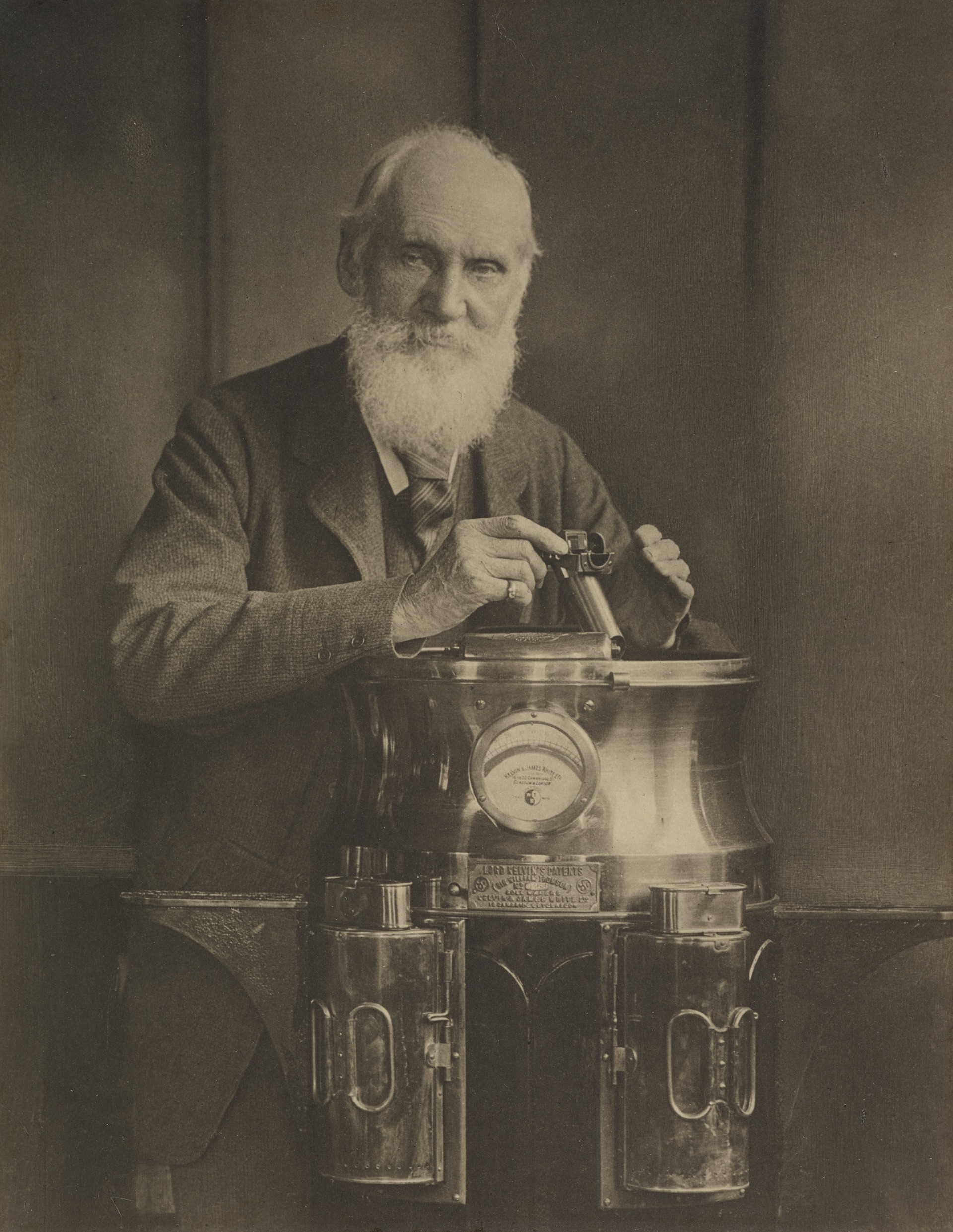$\newcommand{\N}{\mathbb{N}} \newcommand{\Z}{\mathbb{Z}} \newcommand{\Q}{\mathbb{Q}} \newcommand{\R}{\mathbb{R}} \newcommand{\LP}{\left(} \newcommand{\RP}{\right)} \newcommand{\LS}{\left\lbrace} \newcommand{\RS}{\right\rbrace} \newcommand{\LA}{\left\langle} \newcommand{\RA}{\right\rangle} \newcommand{\LB}{\left[} \newcommand{\RB}{\right]} \newcommand{\MM}{\ \middle|\ } \newcommand{\exp}{\text{exp}} \newcommand{\abs}[1]{\left\vert#1\right\vert} \newcommand{\msr}[1]{m\left(#1\right)} \newcommand{\inv}[1]{#1^{-1}} \newcommand{\bkt}[1]{\LA \img{#1}\RA} \require{color}$
The Tanglenomicon
Zachary Bryhtan, Nicholas Connolly, Isabel Darcy, Ethan Rooke, Joseph Starr*
Mathematics Department at The University of Iowa
Knots
The natural question
How many knots?
Knot Tables
Lord Kelvin’s vortex theory of the atom

By Hand
- 1860’s Tait computes knots up to 7 crossings
- 15 knots
- 1870’s Tait, Kirkman, and Little compute knots up to 10 crossings
- Takes about 25 years
- 250 knots
- 1960’s Conway computes knots up to 11 crossings
- “A few hours”
- 802 knots
By Computer
- 1980’s Dowker and Thistlethwaite compute up to 13 crossings
- First using a computer
- 12,966 knots
- 1990’s Hoste, Thistlethwaite, and Weeks compute up to 16 crossings
- Computer runtime on the order of weeks
- 1,701,936 knots
- 2020’s Burton computes up to 19 crossings
- 350 Million knots
Conway
Tangles
“We define a tangle as a portion of a knot diagram from which there emerge just 4 arcs pointing in the compass directions NW, NE, SW, SE.” - Conway, J.H.
Conway, J.H. “An Enumeration of Knots and Links, and Some of Their Algebraic Properties.” In Computational Problems in Abstract Algebra, 329-58. Elsevier, 1970. https://doi.org/10.1016/B978-0-08-012975-4.50034-5
Basic Operations
Operation $+$
Operation $\vee$
The Tanglenomicon
A table of two string tangles
(up to fixed boundary)
Building up
Where we are
Rational Tangles
8,388,608 up to 23 crossings
Montesinos
120,344,744 up to 23 crossings
with non-fixed boundary
Generalized Montesinos
Operation $\circ$
Moon, Hyeyoung, and Isabel K. Darcy. “Tangle Equations Involving Montesinos Links.” Journal of Knot Theory and Its Ramifications 30, no. 08 (July 2021): 2150060. https://doi.org/10.1142/S0218216521500607.
Where we’re going
Algebraic (Arborescent)
All possible tangles made from $+$ and $\vee$ on basic tangles
Arborescent Tangles are constructed by taking a collection of twisted bands described by a weighted tree and connecting them with successive plumbing.
F. Bonahon and L. Siebenmann, New geometric splittings of classical knots, and the classification and symmetries of arborescent knots, http://www-bcf.usc.edu/~fbonahon/Research/Publications.html
Into the future
Non-algebraic/Polygonal
4-valent planar graphs
4-valent planar graph insertions
Technologies
joe-starr.com
Sources
- Dror Bar-Natan The Most Important Missing Infrastructure Project in Knot Theory
- Kauffman, L. H., and S. Lambropoulou. “From Tangle Fractions to DNA.” In Topology in Molecular Biology, edited by Michail Ilych Monastyrsky, 69-110. Biological and Medical Physics, Biomedical Engineering. Berlin, Heidelberg: Springer Berlin Heidelberg, 2007. https://doi.org/10.1007/978-3-540-49858-2_5.
- Moon, Hyeyoung, and Isabel K. Darcy. “Tangle Equations Involving Montesinos Links.” Journal of Knot Theory and Its Ramifications 30, no. 08 (July 2021): 2150060. https://doi.org/10.1142/S0218216521500607.
- Conway, J.H. “An Enumeration of Knots and Links, and Some of Their Algebraic Properties.” In Computational Problems in Abstract Algebra, 329-58. Elsevier, 1970. https://doi.org/10.1016/B978-0-08-012975-4.50034-5.
- Louis H. Kauffman and Sofia Lambropoulou. Classifying and applying rational knots and rational tangles. In DeTurck, editor, Contemporary Mathematics, volume 304, pages 223-259, 2001
- Alain Caudron. Classification des nœuds et des enlacements, volume 4 of Publications Math ́ematiques d’Orsay 82 [Mathematical Publications of Orsay 82]. Universit ́e de ParisSud, D ́epartement de Mathe ́matique, Orsay, 1982.
- Robert Glenn Scharein. Interactive topological drawing. ProQuest LLC, Ann Arbor, MI, 1998. Thesis (Ph.D. The University of British Columbia (Canada). URL: https://www.knotplot.com/.
- Jablan, S., & Sazdanović, R. (2007). Linknot. In Series on Knots and Everything. WORLD SCIENTIFIC. https://doi.org/10.1142/6623
- Dowker, C. H., & Thistlethwaite, M. B. (1983). Classification of knot projections. In Topology and its Applications (Vol. 16, Issue 1, pp. 19-31). Elsevier BV. https://doi.org/10.1016/0166-8641(83)90004-4
- Hoste, J., Thistlethwaite, M., & Weeks, J. (1998). The first 1,701,936 knots. In The Mathematical Intelligencer (Vol. 20, Issue 4, pp. 33-48). Springer Science and Business Media LLC. https://doi.org/10.1007/bf03025227
- Burton, B. A. (2020). The Next 350 Million Knots. Schloss Dagstuhl - Leibniz-Zentrum Für Informatik. https://doi.org/10.4230/LIPICS.SOCG.2020.25
- C. Livingston and A. H. Moore, KnotInfo: Table of Knot Invariants, knotinfo.math.indiana.edu, today’s date (eg. August 24, 2023).
- Schubert, Horst. “Knoten mit zwei Brücken..” Mathematische Zeitschrift 65 (1956): 133-170. http://eudml.org/doc/169591.
- Jos ́e M. Montesinos. Seifert manifolds that are ramified two-sheeted cyclic coverings. Bol. Soc. Mat. Mexicana (2), 18:1-32, 1973.
- F. Bonahon and L. Siebenmann, New geometric splittings of classical knots, and the classification and symmetries of arborescent knots, http://www-bcf.usc.edu/~fbonahon/Research/Publications.html
- Connolly, Nicholas. Classification and Tabulation of 2-String Tangles: The Astronomy of Subtangle Decompositions. University of Iowa, 2021, https://doi.org/10.17077/etd.005978.
Sources
- Facebook, Public domain, via Wikimedia Commons
- FastAPI The MIT License (MIT)
- Carlos Baraza, CC0, via Wikimedia Commons
- Qq1040058283, Public domain, via Wikimedia Commons
- Jeremy Kratz, Public domain, via Wikimedia Commons
- Cython and Python, Apache License 2.0, via Wikimedia Commons
- mermaidjs
- www.python.org, GPL, via Wikimedia Commons
- Mongodb
- Ryan Dahl, MIT, via Wikimedia Commons
- Holger Krekel, CC BY 2.5, via Wikimedia Commons
- Alon Zakai, MIT, via Wikimedia Commons
- Cmake team. The original uploader was Francesco Betti Sorbelli at Italian Wikipedia.. Vectorized by Magasjukur2, CC BY 2.0, via Wikimedia Commons